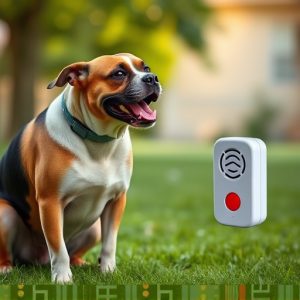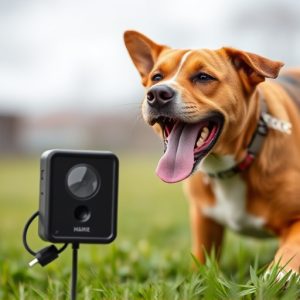Sonic Deterrents: Safe Dog Training with Ultrasonic Technology
Ultrasonic technology in dog training uses high-frequency sound waves (inaudible to humans) to disru…….
Ultrasonic technology in dog training uses high-frequency sound waves (inaudible to humans) to disrupt unwanted behaviors, redirecting dogs' attention without punishment. Sonic deterrents, adjustable within the Sonic Deterrent Range for Dogs (23-64 kHz), are humane, effective, and versatile across various settings. Smaller breeds require lower frequencies (23-40 kHz), while larger dogs might need higher ranges (45+ kHz). With proper supervision and positive reinforcement, these devices foster safe learning environments, making them popular for responsible dog training practices.
“Explore the innovative world of safe dog training with ultrasonic technology, a game-changer in canine behavior modification. This article delves into the science behind sonic deterrents and their effectiveness in addressing unwanted behaviors. From understanding the technology’s mechanics to choosing the optimal sonic range for your dog’s unique needs, we provide insights for responsible training. Discover how these devices work without harm, offering a modern approach to fostering well-behaved pets.”
- Understanding Ultrasonic Technology for Dog Training
- Benefits of Sonic Deterrent Devices for Canine Behavior Modification
- How Sonic Deterrents Work: Principles and Mechanics
- Choosing the Right Sonic Range for Your Dog's Needs
- Implementation and Safety Considerations for Effective Training
Understanding Ultrasonic Technology for Dog Training
Ultrasonic technology in dog training is a safe and effective method that utilizes high-frequency sound waves to communicate with canines. These sounds are inaudible to humans, but dogs can hear them clearly within a specific sonic deterrent range. The technology works by emitting a frequency that disrupts a dog’s ability to focus on certain behaviors or stimuli, effectively redirecting their attention. This approach is particularly useful for modifying unwanted actions like barking, jumping, or chewing without the use of traditional punishment methods.
By targeting specific frequencies, ultrasonic devices can be tailored to different dog breeds and sizes, ensuring a more personalized training experience. These tools operate within a defined range, typically measuring between 23-64 kHz, which is beyond the human hearing spectrum but within the sensitive auditory range of canines. This technology offers a humane alternative to shock collars, promoting positive reinforcement and behavior modification through sound waves alone.
Benefits of Sonic Deterrent Devices for Canine Behavior Modification
Sonic deterrent devices, also known as ultrasonic trainers, offer a humane and effective approach to modifying canine behavior. These innovative tools emit high-frequency sound waves that are inaudible to humans but can capture a dog’s attention and deter unwanted actions. By targeting specific behaviors like barking, jumping, or biting, these devices provide immediate feedback without causing harm or fear. This real-time reinforcement is crucial for dogs as it helps them understand the consequences of their actions and learn new, desired behaviors faster.
One of the significant advantages of ultrasonic deterrent ranges for dogs is their versatility. They can be used to address a wide range of behavioral issues in various settings, from homes to parks. Additionally, these devices are easy to operate—often requiring just a simple click or remote control activation—making them convenient for pet owners. Their non-invasive nature and ability to shape behavior without punishment make sonic deterrents a popular choice for responsible dog training practices.
How Sonic Deterrents Work: Principles and Mechanics
Sonic deterrents, including ultrasonic technology, are designed to train dogs by using sound waves as a guide. These devices emit high-frequency sounds that are typically inaudible to humans but can be heard and felt by canines. The principles behind this method involve capitalizing on a dog’s sensitive hearing and ability to perceive frequencies beyond human range. When activated, the sonic deterrent emits a consistent, high-pitched sound that is unpleasant for dogs, encouraging them to avoid certain areas or behaviors.
The mechanics of sonic deterrents rely on their ability to target specific behaviors without causing harm. The ultrasonic waves can be adjusted to cover a defined Sonic deterrent range for dogs, ensuring the dog receives the signal but people and other animals nearby do not. This selective targeting is crucial in maintaining positive training outcomes while preserving a safe and comfortable environment for all involved.
Choosing the Right Sonic Range for Your Dog's Needs
When selecting an ultrasonic dog training device, one of the crucial factors to consider is the sonic deterrent range. These devices emit high-frequency sound waves that are inaudible to humans but can effectively deter dogs from unwanted behaviors. However, not all devices offer the same sonic range, and choosing the right one depends on your dog’s size, breed, and sensitivity.
For smaller breeds or puppies with more delicate hearing, a lower sonic range (typically between 23-40 kHz) is recommended. This ensures the device is effective without causing any discomfort or potential harm. Conversely, larger dogs or those prone to persistent barking might require a higher sonic range (45-60 kHz or above), which can be more powerful and cover a larger area while still being safe for their sensitive ears.
Implementation and Safety Considerations for Effective Training
The implementation of ultrasonic technology in dog training involves incorporating devices that emit high-frequency sound waves within a specific range, known as sonic deterrents, to modify canine behavior. These devices are designed to be inaudible to humans but can effectively capture a dog’s attention when triggered by unwanted actions like barking or jumping. The key lies in setting the sonic deterrent range appropriately; it should be high enough to avoid human detection and low enough to reach dogs within the desired training area, typically 10-20 feet (3-6 meters).
Safety considerations are paramount during this process. Ensuring the safety of both the dog and humans present is essential. The ultrasonic sound waves should not cause physical harm or discomfort; they are meant only as a gentle deterrent to modify behavior. Training sessions must be supervised, and devices should be used for short intervals to prevent potential sensory overload. Regular breaks and positive reinforcement techniques alongside the sonic deterrent can enhance training effectiveness while maintaining a safe learning environment.
Ultrasonic technology, particularly sonic deterrents, offers a safe and effective approach to dog training by leveraging specific frequencies to modify behavior. By choosing the right sonic range tailored to your dog’s needs and implementing these devices responsibly, you can achieve positive results while ensuring your pet’s well-being. In today’s world, understanding and utilizing this technology can be a game-changer for enhancing canine training methods, fostering better relationships with our furry friends, and promoting safer interactions.


